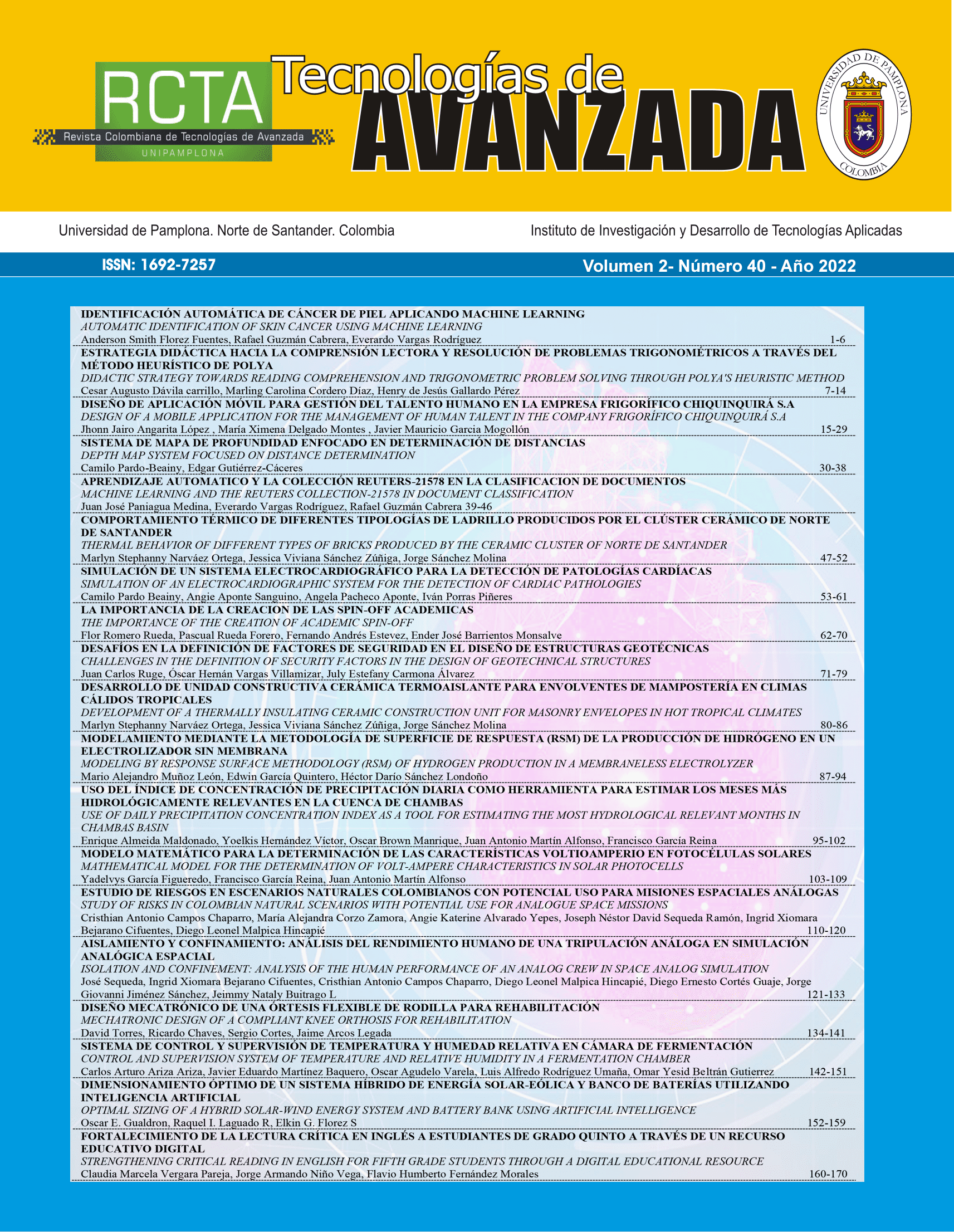APRENDIZAJE AUTOMATICO Y LA COLECCIÓN REUTERS-21578 EN LA CLASIFICACION DE DOCUMENTOS
DOI:
https://doi.org/10.24054/rcta.v2i40.2344Palabras clave:
Clasificación de documentos, naive bayes, regresión logística, SVMResumen
En la actualidad existe una gran facilidad para producir documentos, esto conlleva que exista demasiada información, toda esta información producida es casi imposible de organizar si no se utilizan métodos automáticos. La clasificación automática de documentos puede definirse como una acción ejecutada por un sistema artificial sobre un conjunto de documentos tanto estructurados o no estructurados. Esta acción se realiza utilizando las palabras contenidas en los documentos para definir la clase a la que pertenece el documento de prueba. En este trabajo presenta diversos experimentos de clasificación utilizando la base de datos Reuters-21578 con el fin de observar el comportamiento de los clasificadores naive bayes, máquinas de vectores de soporte (SVM por sus siglas en inglés) y regresión logística. Los resultados obtenidos permiten conocer el desempeño de los clasificadores, su comportamiento al aplicar técnicas de limpieza para la disminución de la dimensión de los documentos y diferentes escenarios de clasificación.
Descargas
Citas
Kaufman, L., & Rousseeuw, P. J. (2009). Finding groups in data: an introduction to cluster analysis. John Wiley & Sons.
de Dios, J. (2009). Clasificación Automática de Textos usando Reducción de Clases basada en Prototipos.
Sebastiani, F. (2005). Text categorization. In Encyclopedia of database technologies and applications (pp. 683-687). IGI Global.
Hearst, M. A., & Pedersen, J. O. (1996, August). Reexamining the cluster hypothesis: Scatter/gather on retrieval results. In Proceedings of the 19th annual international ACM SIGIR conference on Research and development in information retrieval, 76-84
Macskassy, S. A., Banerjee, A., Davison, B. D., & Hirsh, H. (1998, August). Human Performance on Clustering Web Pages: A Preliminary Study. 264-268
Paniagua, J., Vargas, E., Guzmán, R. (2021). Clasificación automática de documentos utilizando aprendizaje automático y Reuters-21578. CIENERGIA UG 2021,43-47.
Bidi, N., & Elberrichi, Z. (2016, November). Feature selection for text classification using genetic algorithms. In 2016 8th International Conference on Modelling, Identification and Control (ICMIC) (pp. 806-810). IEEE.
Eluri, V. R., Ramesh, M., Al-Jabri, A. S. M., & Jane, M. (2016, March). A comparative study of various clustering techniques on big data sets using Apache Mahout. In 2016 3rd MEC International Conference on Big Data and Smart City (ICBDSC) (pp. 1-4). IEEE.
Suh, J. H. (2016). Comparing writing style feature-based classification methods for estimating user reputations in social media. SpringerPlus, 5(1), 1-27.
Montero, S. C., Hernández, K. M., Murillo, É. C., de León, J. A. L., & Hernández-Delgado, M. (2018). Análisis de texto para la identificación automática de marcadores lingüísticos definicionales en recetas de gastronomía de Costa Rica. Káñina, 42(3), 65-78.
Briceño Segovia, F. S. (2018). Clasificación automática de textos basado en ranking.
Ocampo Vargas, M. J. (2020). Análisis automático de documentos con contenido histórico en español.
Smalbil, J. (2020). Web-Based Economic Activity Classification: Comparing semi-supervised text classification methods to deal with noisy labels.
Vala, M., & Gandhi, J. (2015). Survey of text classification technique and compare classifier. International Journal of Innovative Research in Computer and Communication Engineering, 3(11), 10809-10813.
Al-Tahrawi, M. M. (2016). Polynomial Neural Networks versus Other Arabic Text Classifiers. J. Softw., 11(4), 418-430.
Lewis, D. (1997). Reuters-21578 text categorization test collection, distribution 1.0. http://www. research/. att. com.
Hernández, C., & Rodríguez, J. E. R. (2008). Preprocesamiento de datos estructurados. Revista vínculos, 4(2), 27-48.
Raulji, J. K., & Saini, J. R. (2016). Stop-word removal algorithm and its implementation for Sanskrit language. International Journal of Computer Applications, 150(2), 15-17.
Balakrishnan, V., & Lloyd-Yemoh, E. (2014). Stemming and lemmatization: a comparison of retrieval performances, 174-179.
Zhang, Y., Jin, R., & Zhou, Z. H. (2010). Understanding bag-of-words model: a statistical framework. International Journal of Machine Learning and Cybernetics, 1(1), 43-52.
Webb, G. I., Keogh, E., & Miikkulainen, R. J. E. o. m. l. (2010). Naïve Bayes. 15, 713-714.
Cristianini, N., & Shawe-Taylor, J. (2000). An introduction to support vector machines and other kernel-based learning methods. Cambridge university press.
Williams, D., Liao, X., Xue, Y., & Carin, L. (2005, August). Incomplete-data classification using logistic regression. In Proceedings of the 22nd International Conference on Machine learning (pp. 972-979).
Kohavi, R. (1995). A study of cross-validation and bootstrap for accuracy estimation and model selection. Paper presented at the Ijcai.
Sandoval, L. (2018). Algoritmos de aprendizaje automático para análisis y predicción de datos. Revista Tecnológica; no. 11.
Melamed, I. D., Green, R., & Turian, J. (2003). Precision and recall of machine translation. In Companion Volume of the Proceedings of HLT-NAACL 2003-Short Papers (pp. 61-63).
Descargas
Publicado
Versiones
- 2022-07-25 (6)
- 2022-07-25 (5)
- 2022-07-25 (4)
- 2022-08-07 (3)
- 2023-07-19 (2)
- 2023-05-02 (1)
Cómo citar
Número
Sección
Licencia
Derechos de autor 2022 REVISTA COLOMBIANA DE TECNOLOGIAS DE AVANZADA (RCTA)

Esta obra está bajo una licencia internacional Creative Commons Atribución-NoComercial 4.0.














